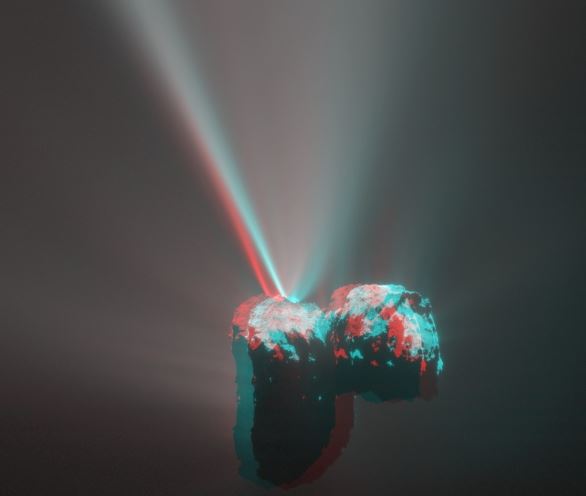Scientists were surprised to find a high proportion of oxygen molecules in the atmosphere of Comet 67P/Churyumov-Gerasimenko, after carrying out a chemical analysis. Such molecules, while common in Earth’s atmosphere, had originally been ruled out as far as comets were concerned.
Early on in the ROSINA mass spectrometer mission in September 2014, scientists from Switzerland, USA, Israel, France, Belgium, The Netherlands, and Germany made a suprising discovery when analyzing the comet’s atmosphere.
Between expected peak values of methanol and sulfur, clear traces of O2 (oxygen) molecules were detected.
 ‘Portrait’ taken in September 2014 of Comet 67P, with Rosetta’s camera system when the space probe was 28km from the comet and the mass spectrometer ROSINA was collecting data. (Image: University of Bern. Credit: ESA/Rosetta/NAVCAM)
‘Portrait’ taken in September 2014 of Comet 67P, with Rosetta’s camera system when the space probe was 28km from the comet and the mass spectrometer ROSINA was collecting data. (Image: University of Bern. Credit: ESA/Rosetta/NAVCAM)
Chemically, oxygen is highly reactive – a trait that led scientists to presume that in the early solar system it must have combined with hydrogen, which was then present in the form of water.
Yet oxygen molecules were clearly present on the comet.
Lead author, Research Fellow André Bieler, a physicist at the University of Michigan in Ann Arbor, said:
“As soon as we got close enough to the comet, we actually found it right away.”
Oxygen survives a long time without combining with other substances
Co-author, Prof. Kathrin Altwegg, project leader of the ROSINA mass spectrometer, said:
“We had never thought that oxygen could ‘survive’ for billions of years without combining with other substances.”
Their findings will be published in the peer-reviewed scientific journal Nature.
Not visible from Earth
It is very difficult to detect molecular oxygen using spectroscopic measurements from telescopes, which explains why O2 had not already been seen on other comets.
In order to make this discovery, an in situ measurement by the ROSINA mass spectrometer was required.
 3D image showing a jet of water and dust coming off comet 67P. (Image: Nature. Credit: D. Romeuf/ESA/Rosetta/MPS/OSIRIS)
3D image showing a jet of water and dust coming off comet 67P. (Image: Nature. Credit: D. Romeuf/ESA/Rosetta/MPS/OSIRIS)
Prof: Altwegg said:
“It was also astonishing that the ratio of water to oxygen didn’t change in different locations on the comet or over time – so there is a stable correlation between water and oxygen.”
Ancient substance
Oxygen molecules are known to occur on the moons of Saturn and Jupiter. Researchers say it is because they were struck by high-energy particles from their respective mother planets, which does not exist in the comet’s case.
Comet 67P has been bombarded for 4.6 billion years, though, by high-energy cosmic radiation particles, which can split water. When the water was split, hydrogen, oxygen and ozone, among other substances, were formed.
Comet gradually losing mass
However, these particles only penetrate a few feet into the surface. Each time it revolves around the Sun, the comet loses from one to ten meters from its circumference. Since it last met Jupiter in 1959, which set the comet on its current orbit, it has lost over 100 meters of its material.
The authors believe it is highly likely that the comet’s oxygen originated a very long time ago, before our solar system was formed.
Specifically, grains of ice in the cold, dense birthplaces of stars (dark nebulae) were stuck by high-energy particles, and split water into hydrogen and oxygen.
The oxygen, they explained, was not further ‘processed’ in the early solar system.
The oxygen measurements show that a significant part of the comet’s material is older than our solar system and has a composition typical of dark nebulae, from which solar nebulae and then planetary systems originate.
Prof. Altwegg said:
“This evidence of oxygen as an ancient substance will likely discredit some theoretical models of the formation of the solar system.”
Paul Feldman, an astronomer at Johns Hopkins University in Baltimore, Maryland, a co-investigator on another Rosetta spectrometer, Alice said of the research team:
“It’s a tour de force. I think they’ve done a very nice job.”
Bieler said further research will be needed to determine what the detection of oxygen really means. “We think this result is of interest beyond the cometary community because it forces us to rethink all of these models,” he said.
Citation: “Abundant molecular oxygen in the coma of comet 67P/Churyumov–Gerasimenko,” A. Bieler, K. Altwegg, H. Balsiger, A. Bar-Nun, J.-J. Berthelier, P. Bochsler, C. Briois, U. Calmonte, M. Combi, J. De Keyser, E. F. van Dishoeck, B. Fiethe, S. A. Fuselier, S. Gasc, T. I. Gombosi, K. C. Hansen, M. Hässig, A. Jäckel, E. Kopp, A. Korth, L. Le Roy, U. Mall, R. Maggiolo, B. Marty, O. Mousis, T. Owen, H. Rème, M. Rubin, T. Sémon, C.-Y. Tzou, J. H. Waite, C. Walsh & P. Wurz. Nature 526, 678–681 (29 October 2015). DOI:10.1038/nature15707.
Video – Oxygen found on comet 67P
